Are you looking to make the most of your apartment’s space while achieving your goals? It can be difficult to figure out how best to use a limited amount of room, but with a few helpful tips and tricks up your sleeve, you’ll be able to maximize the capabilities of even the smallest apartments. Whether it’s adding extra storage or utilizing multi-functional items, this article outlines five great tips on how to achieve your apartment goals. From removing clutter and optimizing lighting all the way to rearranging furniture and views – Check out our selection today at https://impeccablenestdesign.com/ and start living the life you deserve.
Maximizing Small Spaces: Creative Storage Solutions
Living in a small space can be challenging, and making the most of your available space is essential. It is critical to maximize small spaces with creative storage solutions in order to keep your home neat and orderly while eliminating unnecessary clutter. Storage solutions that maximize your small space are not only functional, but they also provide you with a versatile option for customizing any room’s decor with efficiently organized furniture selections.
Begin by making sure that all of your existing furniture is as versatile as possible. Ottomans and benches, for example, can provide both seating and hidden storage compartments. When possible, try to incorporate built-in shelving units, which work especially well in kitchen pantries or along the upper walls of bedrooms. Furthermore, wall-mounted shelves maximize both vertical and horizontal wall space for targeted storage throughout your home’s various rooms.
Thinking outside the traditional style box and looking for more unconventional options to spruce up a room can also lead to creative storage solutions. There are numerous options available on the market today, ranging from colorful hanging baskets to rolling modular cubes that double as footstools. Using wall-mounted pegboards or other wall organizers is another great way to store items out of sight while also incorporating them into room decorations through artful styling techniques.
If repurposing or rearranging furniture isn’t an option, windowsills can sometimes provide an alternative, especially if they run along larger walls like those found in living rooms or dining rooms. Windowsill bookshelves provide additional accessible interior display surfaces near places that would otherwise be dormant; in addition, offering free outdoor dressing via window boxes used in flower beds or planters extends a residence’s organicness through readily visible facility growth wherever width constraints require. Don’t forget about ceiling hangings: hang racks, floating shelves, or even decorative mirrors from the ceiling to create tailored accent pieces without taking up valuable floor space!
Finally, there is no one-size-fits-all solution for maximizing small spaces with creative storage solutions; experimentation and exploration are essential! Whether it’s using baskets disguised as side tables or hiding unsightly cluttered spots behind accordion doors, carving out extra space from unused corners shouldn’t cause undue stress or take too long to craft, and it should include a comfortable finishing touch around any living specimen!
Increasing Aesthetics & Comfort: Easy Ways to Improve Your Apartment’s Interior Design
When it comes to apartment interior design, aesthetics and comfort are crucial. Making an apartment feel comfortable and homey requires creating a pleasant and inviting atmosphere. There are several simple ways to improve your interior design and create a stylish, relaxing environment that will make anyone want to stay at home.
Making minor changes to the walls is a simple way to improve the aesthetics of your apartment’s interior design. If you don’t want to get too creative with paint, wallpaper or wall decals are great options, while painting accent walls can help add dimension without having to overhaul the entire room. Try using colorful wallpaper to brighten up smaller spaces like hallways and bathrooms or adding vertical stripes to living rooms. Wall art, such as prints, mirrors, and tapestries, can also add instant character to any space.
Updating furniture is another low-effort but effective way to improve the interior design of your apartment. Adding statement pieces such as a one-of-a-kind couch, rug, or coffee table can instantly refresh your entire look. If buying new isn’t an option, simply reupholstering existing furniture in a different fabric or styling it differently can help create a new look. Making sure the furniture is evenly distributed throughout the room adds definition and flow to the space.
Finally, small details like rugs, throws, pillows, and plants add character and charm to any room. Rugs bring disparate elements together, while soft throws add texture; experiment with color palettes by adding vibrant pillows or choosing interesting textures instead; and houseplants bring life into drab apartments (and can actually purify the air). The options are limitless; experiment until you find something that suits your personal style!
You can easily transform any plain apartment into an attractive oasis that not only looks good but also improves comfort levels by following these simple tips. Upgrade existing items around the house or simply add lovely finishing touches—either way, increasing aesthetics and comfort is a never-ending process!
Saving Money & Energy: Tips for Making the Most of Your Resources
Saving money and energy is a significant goal that many people strive to achieve. This can help you reduce your carbon footprint, save money on your utility bills, and live a more sustainable lifestyle. Fortunately, there are numerous resources for making the most of resources when it comes to energy efficiency and budgeting.
One way to save energy (and money) is to be mindful of how frequently you use it throughout the day. This can be accomplished simply by opening curtains or blinds during the day to allow natural sunlight into your rooms rather than using as much electric lighting as possible. Avoiding leaving lights on when they are not needed will also have a significant impact. Furthermore, switching to LED lighting instead of traditional bulbs will reduce your power bill while providing better-quality illumination.
Another way to save money is to use water more efficiently, which reduces both resource consumption and waste. Turning off the water while brushing your teeth or shaving, for example, will prevent unnecessary water from being drained down the drain. Other water-saving measures include installing low-flow showerheads, installing aerators on sinks, and quickly repairing leaking fixtures to prevent further damage from occurring over time due to high wear and tear.
When it comes to cooking meals at home, it’s best to plan ahead by making an ingredient list and a grocery list. This not only reduces food waste that would otherwise go unused, but it also aids in meal planning and preparation prior to visiting the store, which ultimately prevents overspending because shoppers haven’t gone off an impulse buy outside their budget limit that has already been pre-determined based on what’s needed for specific recipes following preplanned meals. Incorporating leftovers into other dishes later in the week is another great way to ensure that no nutrition is wasted while also saving money!
Energy savings do not always require extra hours spent adjusting habits around the house; sometimes purchasing new appliances with higher energy ratings printed on them can provide large savings just from one purchase alone, and without sacrificing convenience! Unplugging items not in use, such as phones and laptop chargers, turning off electronics if not in use for extended periods (such as TVs when going away), and using blockers so hot water tanks do not run continuously unnecessarily are all small steps that can add up over time to lower resource utilization across multiple areas throughout homes, resulting in greater financial freedom at the end of the month’s bill arrival period each quarter!
Keeping Organized: Strategies to Reduce Clutter and Keep It That Way
The first step toward organization is to declutter. Keep in mind that all of your possessions should be worth their space in terms of beauty, utility, or meaning. Take a look around your home or workspace and ask yourself, “Is this item serving a purpose, adding beauty, or bringing me joy?” If you answered ‘no’ to any of these questions, consider removing the item. Taking out what you don’t need immediately creates more space, making cleaning up easier. There are several elimination techniques, such as discarding broken items or sorting by frequency of use; whatever makes sense for how you approach your items, find one that works best for you.
Use clever organization strategies such as color coding and labeling areas or boxes after unwanted objects have been discarded or properly stored. This will help you visualize where certain items go or what goes with other items, reducing mess and stress levels. You may also want to invest in storage containers such as cubes, bins, and baskets so that similar components are grouped together rather than scattered throughout the space; hangers may also be useful if you don’t have unlimited closet space, such as stacking tanks and shirts on top of each other inside drawers. Don’t forget about dividers; they’re great for organizing socks and underwear, but they could also be used to separate foods on pantry shelves!
One thing that many people overlook when organizing their space is taking 10-15 minutes every day to maintain it. Setting a timer for 15 minutes per day could make all the difference in keeping things from spiraling out of control again. Furthermore, seasonal changes mean that there may be clothes we no longer need (such as winter clothes in the spring), so why not get rid of them? Or should you do a deep cleaning every four months? Create an achievable routine based on busy times where organizing will not require much effort but will still help the overall look and feel while ensuring everything is perfectly placed even after a few weeks of following usagesl again. Furthermore, seasonal changes mean that there may be clothes we no longer need (such as winter clothes in the spring), so why not get rid of them? Or should you do a deep cleaning every four months? Create an achievable routine based on busy times where organizing will not require much effort but will still help the overall look and feel while ensuring everything is perfectly placed even after a few weeks of following usages (gaming consoles under TV cables neatly connected, and so on).
Using these strategies, along with reminding ourselves on a regular basis to keep our surroundings clean, can help us stay organized. Additionally, whenever possible, try to involve family members, as this will involve community support and motivation. Kids love suggesting small activity-related practices, and it can become an interesting game between siblings who often try to compete with each other in being better organizers. Finally, staying organized not only feels good while saving time spent looking for things, but it also prevents clutter from accumulating in our homes!
Safety First: How to Make Sure You Are Protected in Your Rental Home
When looking for a rental home, safety should be a top priority. After all, renters need to know that their belongings and lives will be safe while living on the property. Whether renting a flat or a house, it is critical to conduct research and put safeguards in place to ensure everyone’s safety.
Before signing a lease on your next rental home, there are several steps you should take to ensure your safety:
Examine the Property
Look around the property both during the day and at night. Are the sidewalks illuminated? Does it appear that neighbors maintain their front yards? Where can I find the nearest police station? If you believe the neighborhood lacks safety features, speak with your landlord about installing proper lighting, locks, and security cameras to monitor activity around the unit.
Obtain Insurance
Your rental agreement may require you to obtain renter’s insurance to cover any items lost or stolen from inside or outside your home. This provides you with financial security if something were to go wrong in your home.
Windows and Doors
While walking through the premises, inspect each door and window for any wear and tear that could compromise security over time. If a keyless lock isn’t already installed on an exterior door, ask your landlord if one can be installed so that no unwanted guests can enter your home without your permission.
Use Smart Devices
When properly placed within your unit, technology can be used as a safeguard against potential threats such as theft and fire. Smoke alarms, motion sensors, and carbon monoxide detectors can all provide critical alerts if something dangerous happens while no one is at home. Smart devices, such as thermostats and lighting systems, make it possible to control temperature and brightness settings even when you are not at home!
Overall, taking precautionary measures to keep yourself safe inside your rental home is critical for establishing long-term tenantship with both landlords and neighborhoods! Renters can ensure that their prized possessions and loved ones are protected every step of the way by reviewing each individual part of the property before moving in, purchasing dependable insurance coverage, fortifying openings throughout their new abode, and utilizing pertinent tech tools at hand!
Let’s start in the apartment’s living room.
In our opinion, the half-wall and iron grate are the keys to this design. This feature divides the living space seamlessly and allows for a clear definition of rooms without closing off the space.
Onto the kitchen!
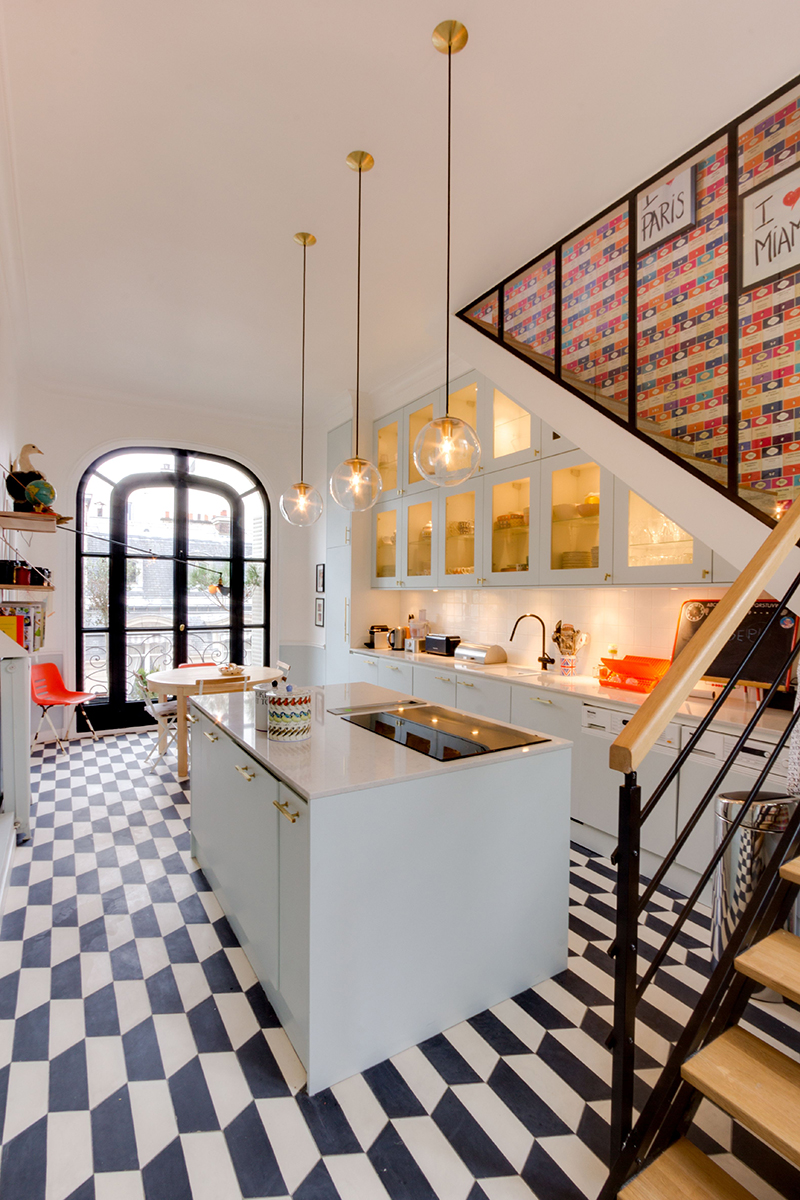
This kitchen is right in so many ways! First, we are obsessed with how the floor is the star of the show, and, though they are simple, the cabinets are thoughtfully designed. Secondly, those pendant lights above the island are the perfect modern touch to warm up the space. And finally, those truly unique arched French doors maintain the vintage character of the flat and let natural light flood the space.
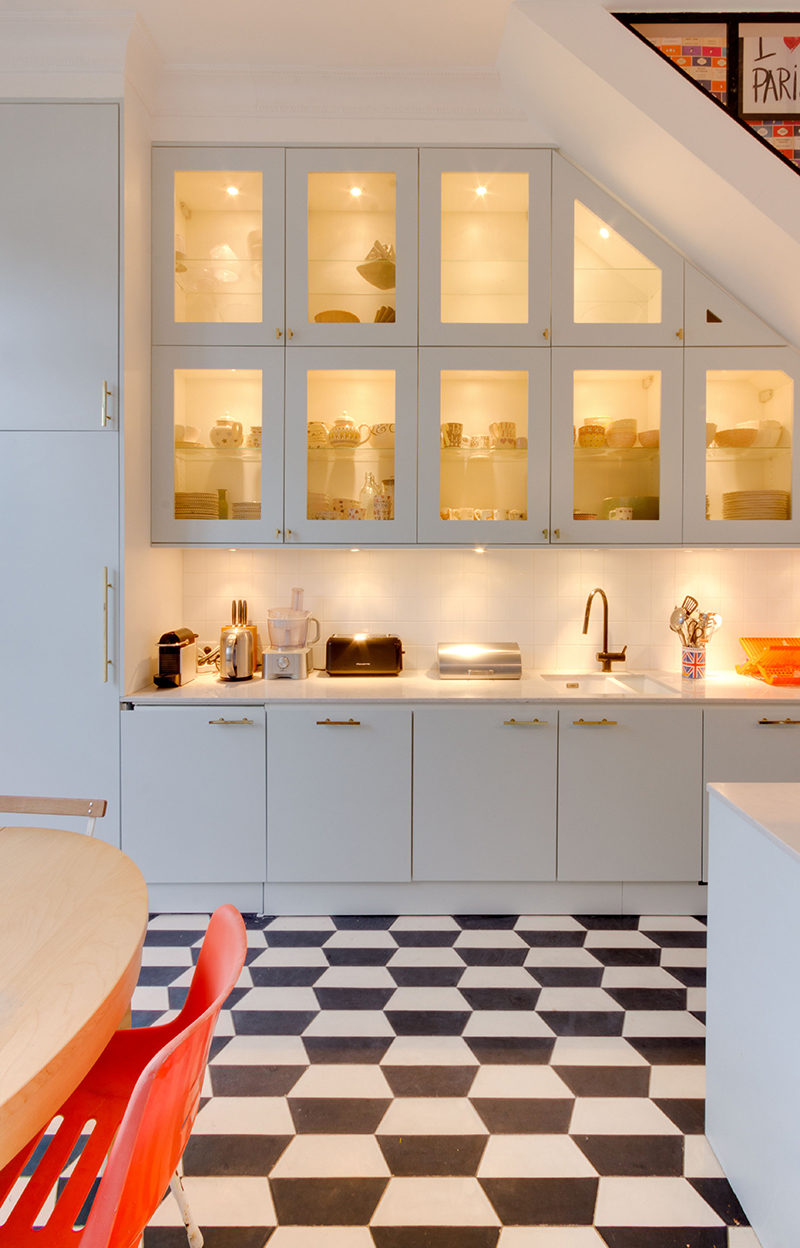
We’re dying to see the bathroom next.
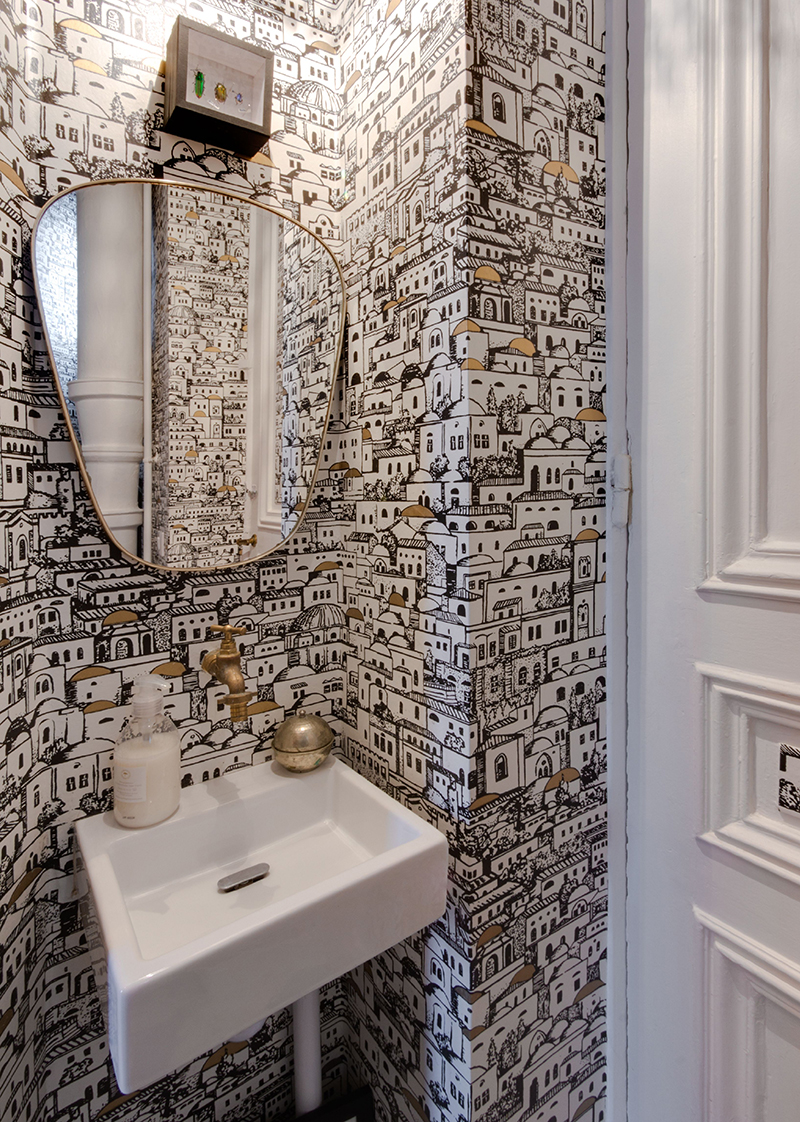
The minimal color palette in this bathroom makes this cityscape wallpaper totally pop without being overwhelming. Even in this small space, the brass-trimmed mirror and garden hose faucet have the chance to shine.

Black and white bathrooms don’t have to look sterile! Natural elements, such as wicker accents and marble half-walls, perfectly warm up the room and make it fabulously inviting for a luxurious soak in the tub. And we can’t even get over the choice to carry the floor tile to the countertop—talk about inspo!
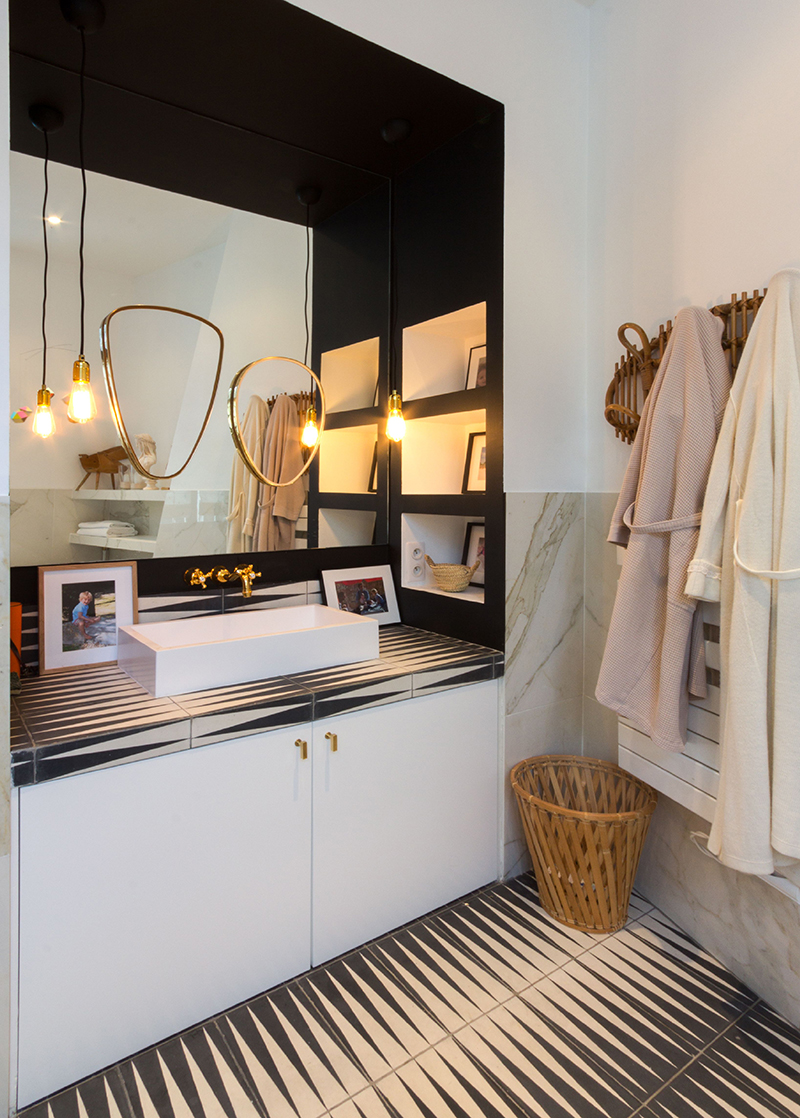
Show us the bedroom!
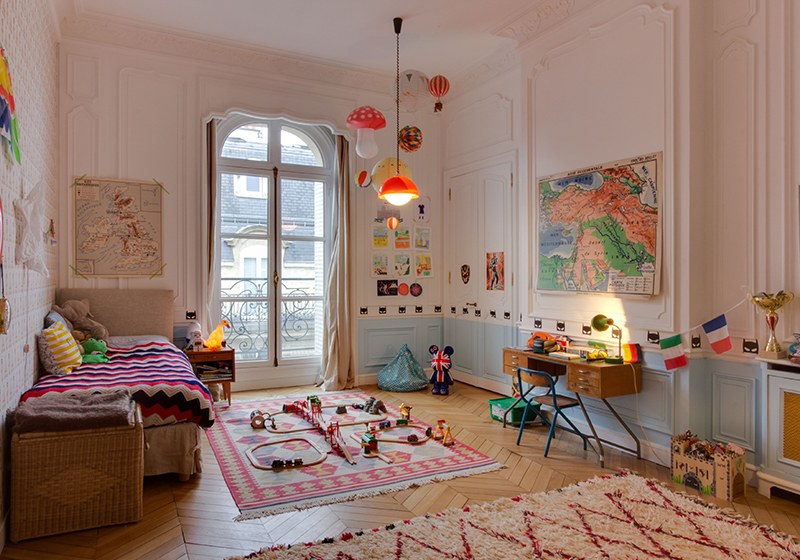
Talk about the ultimate bohemian chic bedroom! We feel like this room is the perfect example of how to bring eclectic style to any apartment. It takes true design talent to layer four patterned rugs and make them look effortless. And while we like to see rugs on the floor, we also love to see them on the walls. The Moroccan-style tapestry is the best way to prevent the small yet adorable sun mirror from getting lost. Finally, if you’ve been looking for inspiration for your gallery wall, look no further. This Parisian apartment makes excellent use of awkward space around a large opening with an eye-catching gallery wall!
Who says an apartment can’t fit a family? Let’s see the kids’ rooms and nursery!

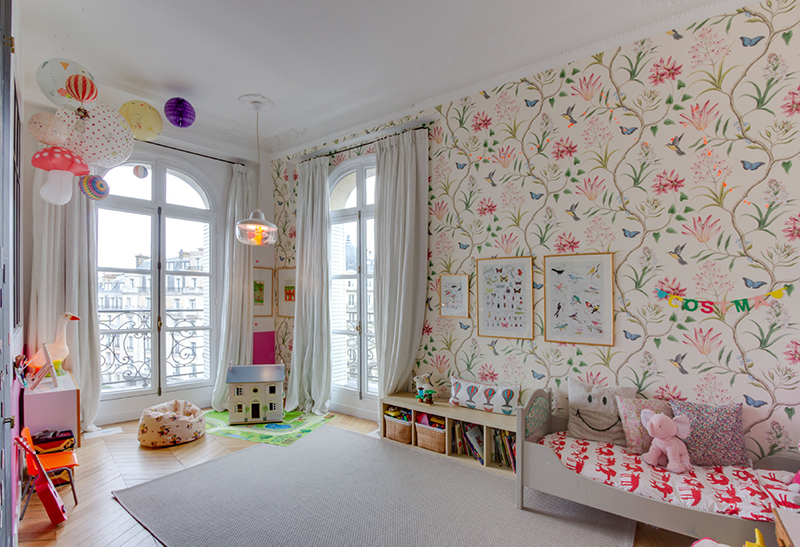

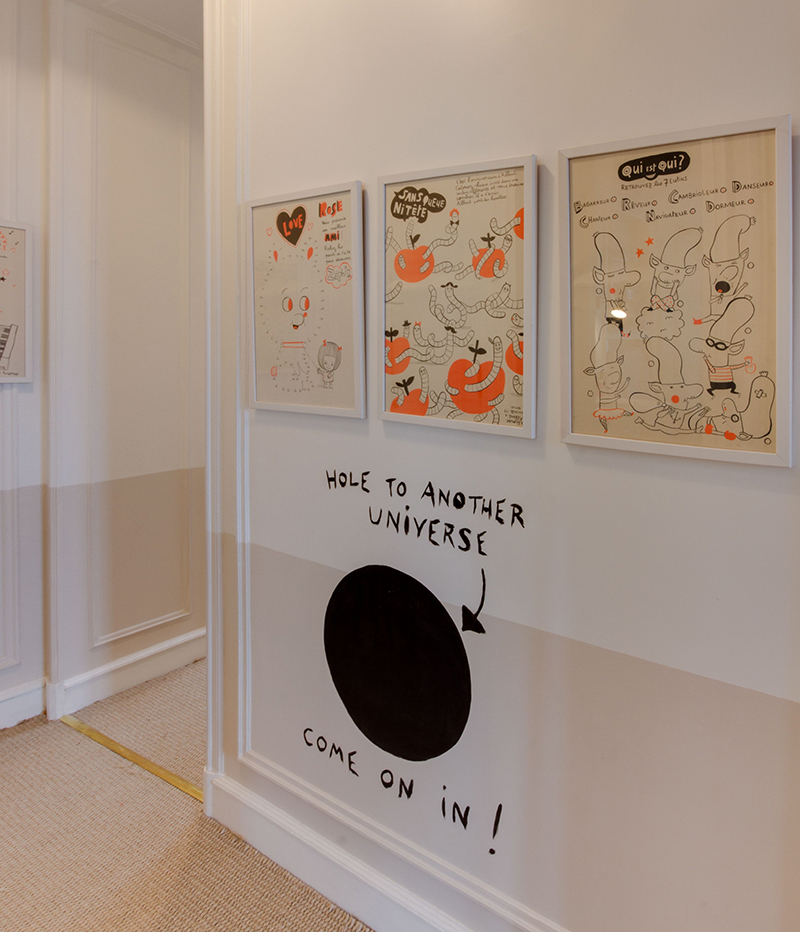
Whimsy is the name of the game when it comes to kids’ rooms! Sweet, pastel color combinations prevent the wide color palettes from being overwhelming, and consistent features, like paper lantern clusters, connect each room. Our favorite part is the “hole to another universe” painted on the wall, which is the ultimate whimsical touch and plays with any kid’s imagination.
Finally, here are all of the details throughout the apartment that make it one-of-a-kind.
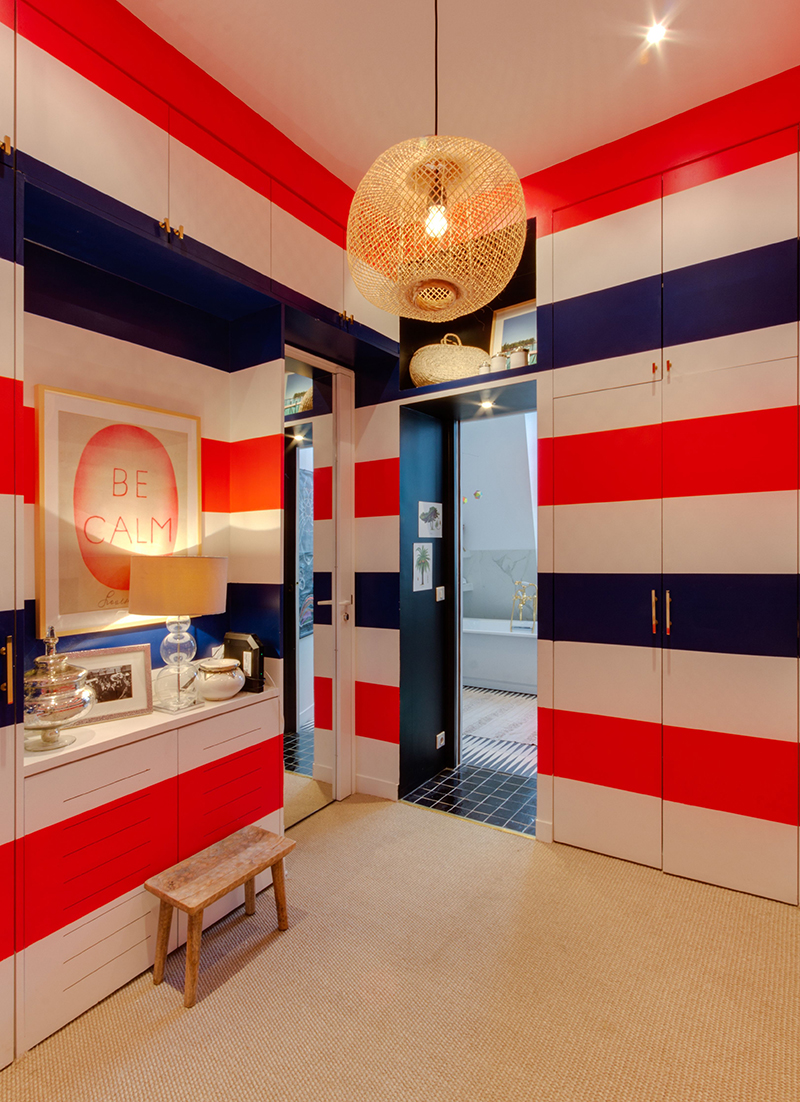
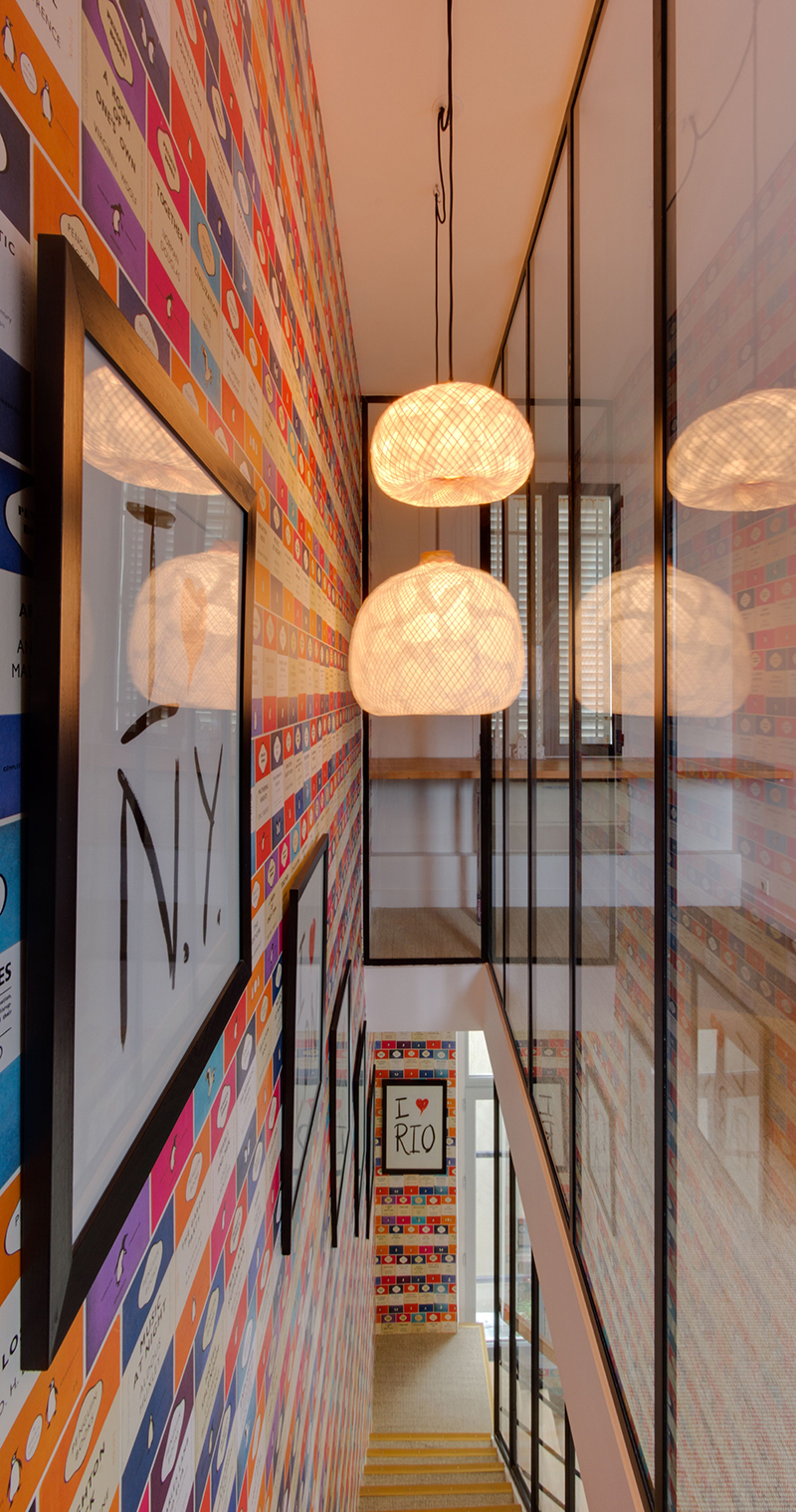
Are you swooning yet? We sure are! Tell us what you think below and if there are any elements you’d like in your own home!
Conclusion
Achieving goals for your apartment doesn’t have to be a stressful process. With the five tips provided, you can create a livable and organized space that suits your needs perfectly. From utilizing multifunctional furniture and fixtures to committing to regular decluttering, organizing, and repurposing routines, you can make the most of every inch of your home, regardless of size. It’s simple: get creative with solutions, and you’re well on your way to completing any apartment project.
Excerpt
Achieve your apartment goals with these five tips! Maximize space with multi-functional furniture, keep purchase quantities to a minimum, and choose the right color palette. Maximize storage with shelves and cabinets, create flow in the space, and utilize vertical elements in creative ways.
If you like bold and whimsical decor, check out our blog on Foo Dogs.
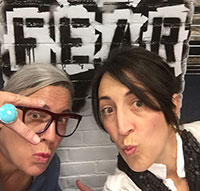
We’re Emma Carole Paradis and Kimberly Carole, the owners and designers of Impeccable Nest, based in Bedford, New Hampshire. A mother-daughter team with a love of design. Originally from Manhattan Beach, California, now based in Bedford, New Hampshire, we bring a Southern California cool and New England tradition to our design. Not only do we work together…we also live together in a multi-generational home…and a home that they are known to design for others.
